While I’m a big fan of digital detoxing, there are plenty of good reasons to bring a portable solar panel camping, like being able to charge devices, photo equipment or even your laptop so you can work remotely while enjoying the outdoors.
There are a lot of options when it comes to solar panel chargers. In choosing the best solar chargers for camping, I only included ones which fit these requirements:
- 15 to 100 watts: Anything less than 15 watts won’t keep you reliably powered. And chargers larger than 100W aren’t very portable and are better suited for RVs.
- Portable: Don’t need to be mounted, are light enough to carry around camp and will easily fit in your car.
- USB out ports: So you can directly charge phones, tablets and other small devices without conversion cables.
- Durable: Ideally waterproof and able to handle falling over in bad conditions.
- Extra features: Like being chainable or compatible with power stations.
Top Picks:
- Best Overall: Goal Zero Nomad 50
- Runner Up: Jackery SolarSaga 60W or 100W
- Best Small Solar Charger: Anker PowerPort 15W
- Best Budget Pick: BigBlue 100W
Comparison Table
*Note that the price-per-watt was based on prices at time of writing. Prices may change!
| Product | Watts | Weight | Size Folded | Blocking Diode | Chainable | Ports | Price Per Watt |
|---|---|---|---|---|---|---|---|
| Goal Zero Nomad 50 | 50 | 6.85lbs | 17x11.25" | Yes | Yes | USB-A, 8mm | 5 |
| Jackery SolarSaga 60 | 60 | 6.6lbs | 21x16.7" | Yes | Yes | USB-A, USB-C, DC | 3.3 |
| Jackery SolarSaga 100 | 100 | 10.33lbs | 24x21" | Yes | Yes | USB-A, USB-C, DC | 3 |
| Renogy E Flex 50 | 50 | 5.25lbs | 20x16x" | Yes | Yes | USB-A, USB-C, DC | 2.8 |
| Anker PowerPort 15W | 15 | 12.5oz | 11x6.3" | Yes | No | USB-A | 3.3 |
| RokPals 60W | 60 | 7.6lbs | 13.8x13.4" | No | Yes | USB QC3.0, USB-C, DC | 3 |
| RokPals 100W | 100 | 9.5lbs | 17.3x14.6" | No | Yes | USB QC3.0, USB-C, DC | 2.8 |
| Togo Power 60W | 60 | 6.5lbs | 16x14.5" | Yes | Yes | USB QC3.0, USB-C, DC | 2.8 |
| Togo Power 100W | 100 | 8.6lbs | 24x21" | Yes | Yes | USB QC3.0, USB-C, DC | 2.6 |
| SolarFairy 100W | 100 | 5.1lbs | 11.2x7.8" | Yes | No | USB-A, USB-C PD, DC 19V, DC 14V | 2 |
| Big Blue 28W | 28 | 1.3lbs | 11.1×6.3" | No | No | USB-A | 2.5 |
| BigBlue 42W | 42 | 2lbs | 11x5.5" | Yes | Yes | USB-A, USB-C, DC | 2.1 |
| BigBlue 63W | 63 | 2.9lbs | 11.4x6.9" | Yes | Yes | USB-A, USB-C, DC | 1.5 |
| BigBlue 100W | 100 | 8.8lbs | 15.2x8.2" | Yes | Yes | USB-A, USB-C PD, DC | 1.6 |
Best Portable Camping Solar Panels
1. Anker 15W PowerPort Solar Panel
Verdict: Choose if you need a lightweight solar panel for occassionally charging small devices
Specs:
- Panel Type: Monocrystalline
- Weight: 12.5oz
- Folded Size: 11 x 6.3 inches
- Open Size: 18.1 x 11 inches
- Outlets: 2x USB-A (2.1A each, 2.1A max)
- Chainable: No
- Available At: Amazon
Review:
The Anker PowerPort is my top pick for ultralight backpacking solar panels. It is just 12.5oz, which means it has 1.2 watts per ounce. Few portable solar panels come close to offering that much power per weight.
While 15W is too low for campers who want to charge laptops or even tablets, it’s just right for keeping your phone, Kindle, or other small devices topped off during occasional use. You’ll probably want to use a power bank as it’s more reliable than direct charging. There are grommets so you can hang it from a tent, your car, backpack, etc. to capture sunlight.
It is designed in a way so the solar panel folds down quite compact but still delivers enough surface area for capturing sunlight. There are smart built-in features like auto-reset so you don’t have to worry about the charger stopping because of passing clouds. There’s also a blocking diode so the charge won’t drain your batteries instead of charging them in low-light situations.
The brand Anker is also highly reputable and known for producing quality power banks and other portable power solutions. If you pair this solar panel with a lightweight power bank, you will have a very efficient, lightweight solar setup for camping or backpacking.
Pros:
- High quality solar panel
- Lightweight setup
- Very portable
- Auto reset and blocking diode
Cons:
- Only USB-A outlets
- Not great at trickle charging
Check Price At Amazon
2. Goal Zero Nomad 50
Verdict: Still the best camping solar panel but has a very high price-per-watt
Specs:
- Panel Type: Monocrystalline
- Weight: 6.85lbs
- Folded Size: 17 x 11.25 x 2.5 inches
- Open Size: 53 x 17 x 1.5 inches
- Outlets: USB-A (5V, 2.4amp) and 8mm (14-22V, 3.5A)
- Chainable: Yes
- Available At: Amazon, REI
Review:
Goal Zero is by far the leader when it comes to portable solar chargers and panels. They make various types. Their small wattage chargers honestly aren’t great compared to the competition. However, their 50W solar charger is perfect for camping.
The Nomad 50W has USB-A ports (5V, 2.4A) and a solar port (blue, 8mm, male). The solar port allows you to charge a power station.
Note the Nomad 100W does NOT have a USB out port. Since the Nomad 50W chargers can be chained together (they can also be chained with the Nomad 100W or Boulder 100W). Even with cables, it almost costs the same two buy two Nomad 50s as one Nomad 100. Thus, I’d go with the Nomad 50 even if you think you might need more power later on.
As for performance, the Goal Zero consistently does well on tests. They also are also very good at handling the elements. Several people have reported that the glue turns liquid in high heat, but not enough for the charger to come apart.
Pros:
- Very reliable brand
- High-quality panels
- Rugged build
- Lightweight and compact for its class
- Mostly waterproof
- Can chain them with other Goal Zero panels
Cons:
- Pricier than lesser-known brands
- Stupidly popular; the 50W panels are often out of stock
- No USB-C outlet
3. Jackery SolarSaga (60W and 100W)
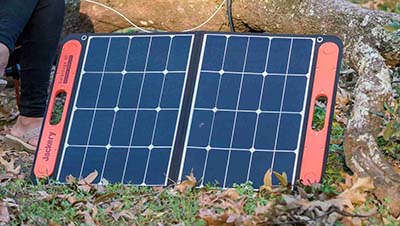
Verdict: All-around great solar panel for camping that is a fraction of the cost of Goal Zero
Specs(for 60w solar panel):
- Panel Type: Monocrystalline
- Weight: 6.6lbs
- Folded Size: 16.8 x 11.4 inches
- Open Size: 35.2 x 16.8 x 0.2 inches
- Outlets: USB-A (5V, 2.4amp), USB-C (5V, 3amp) and DC Output (22V, 3.09A, 68W)
- Chainable: Up to 2 panels parallel
- Available At: Amazon
Review:
Jackery released the SolarSaga in 2020 to compete with the Goal Zero Nomad panels. They are available in 60, 100 and 200 watt sizes.
Like the Nomad, the SolarSaga series are designed to be portable. They have a really nice folding design with a built-in rubberized orange handle. It looks sleek and professional and the hinges between the panels feels sturdy.
There are two USB outlets so you can directly charge devices simultaneously. One of the ports is USB-C, which means you can get a faster charge.
As for the DV outlet: The 60W has an Anderson connection and includes an Anderson-to-8mm cable to be used with the Jackery power station. Their 8mm cable isn’t the same as the Goal Zero cable; it doesn’t fit well in the Yeti power station. If you want to charge a Yeti with the SolarSaga, then you’ll need to get Goal Zero’s adapter cable.
On the Gen 3 update, Jackery got rid of the Anderson on the SolarSaga 100W. Now it has an 8mmm adapter.
While the ultralight design is appealing for portability, it does mean the SolarSaga panels aren’t that durable or tough. You won’t want to leave them unattended; even a slight breeze could send them toppling over. They are water-resistant to IP65, so don’t leave them in the rain either.
How Does It Compare to Goal Zero Solar Chargers?
Compared to the Goal Zero Nomad solar panels, Jackery’s SolarSaga panels are much lighter and thinner. They are half the weight and a fraction of the thickness (2.5 inches compared to 0.2 inches!). There is a built-in kickstand which can be adjusted to preset angles. Another plus is that the SolarSaga chargers support USB-C whereas Goal Zero does not.
While Jackery solar chargers do perform well, the technology doesn’t seem to be as good as with Goal Zero. Some users have reported issues with the blocking diodes: in low light, the SolarSaga actually drained device batteries instead of charging them.
Pros:
- Very lightweight and compact
- USB-A and USB-C ports
- Built-in adjustable kickstand
- Rubberized carrying cable
- Comes with adapters
Cons:
- Not very waterproof
- Easily toppled by wind
- Not compatible with all power stations
Get the 60W Here and 100W Here
4. Renogy E. Flex 50W
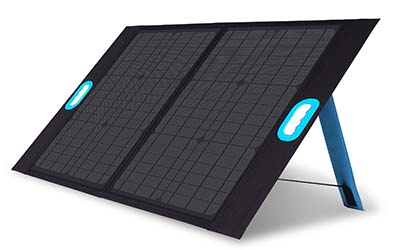
Verdict: Despite some performance issues, it’s still a great value and does its job well enough
Specs:
- Panel Type: Monocrystalline
- Weight: 5.25lbs
- Folded Size: 19.9 x 16.1 x 0.8 inch
- Open Size: 32.5 x 19.9 x 0.2 inch
- Outlets: USB A (5V, 2.4amp), USB-C (5V, 3amp), switchable DC (19V/2.4amp and 16V/2.8amp) and solar connector output (18V, 2.77amp)
- Chainable: Yes
- Available At: Amazon
Review:
Renogy is well known for their affordable solar panels. Most of the Renogy solar panels are not very portable. However, their E. Flex panels are the exception. In particular, their 21, 30 and 50 watt solar panels are portable and light enough to use at camp. Because of some performance issues (they don’t seem to be as efficient as Goal Zero or Jackery), you’ll definitely want to get the higher wattage version.
Before buying this solar charger, make sure it is compatible with your devices. Even though it has an USB-C port, it won’t charge USB-C laptops. You can only charge laptops with 16V or 19V.
The E. Flex 50W does have auto-reset, so you don’t have to worry that the charging will stop if a cloud passes overhead. However, some users did report problems with it and had to unplug/replug devices to get them charging again. Likewise, it doesn’t do great at charging multiple devices at once because of amp drops.
Pros:
- Affordable
- Easy to use
- Good built-in features
- Built-in kickstand
Cons:
- Some issues with the auto reset feature
- Not great at charging multiple devices simultaneously
Check Price At Amazon
5. RockPals Portable Solar Panel 60W and 100W
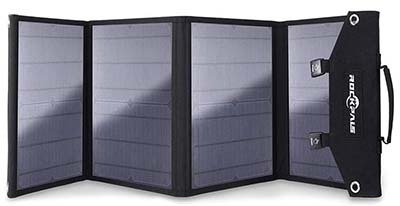
Verdict: Okay choice if you will monitor devices while they charge. Otherwise, spend a bit more to get a SolarSaga.
Specs (for 60W Upgrade):
- Panel Type: Monocrystalline
- Weight: 7.3lbs
- Folded Size: 13.8 x 13.39 x 2.36 inches
- Open Size: 58.2 x 13.8 x 0.2 inches
- Outlets: 1x USB QC3.0 (3.3A), 1x USB-C (18W max), DC 18V/3.3A
- Chainable: Yes
- Available At: Amazon
Review:
At first glance, RockPals solar chargers look great. They are very popular and get good reviews. The RockPals chargers also have multiple charging options, including USB-C, and are compatible with most power stations.
Yet, there is a reason that RockPals solar chargers are cheaper than brands like Jackery and Goal Zero: they tech isn’t nearly as good.
The main issue is that RockPals chargers don’t have a blocking diode. This means the solar charger could actually cause your device battery to drain instead of charge. Trickle charging is almost impossible because of this.
Another issue is that the RockPals solar chargers don’t withstand high temperatures as well as some other camping solar panels. It has a max operating temperature of 120F. The panel can easily reach that temperature in summer, so you’ll need to place a white cloth (or similar) underneath the panel to reduce heat absorption into the panel.
Pros:
- Compact 4-fold design
- Quality panel
- Comes with adapters
Cons:
- Overheats easily
- Not chainable
- No blocking diode
6. TogoPower 60W and 100W
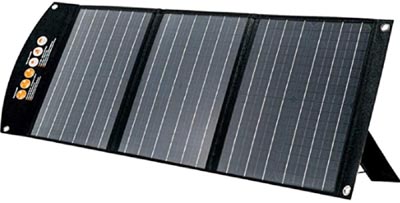
Verdict: Good choice if you are on a tight budget and know which cables you need
Specs (for 60W panel):
- Panel Type: Monocrystalline
- Weight: 6.5lbs
- Folded Size: 16×14.5×1.9″
- Open Size: 50.7 x 16 x 1 inches
- Outlets: USB QC3.0 (5-12V 3.4A max), USB-C (5-15V, 4.5A max), DC (18V/5.5A max)
- Chainable: Yes
- Available At: Amazon
Review:
Togo is a Chinese brand which makes cheap solar panels. I’m wary of buying from no-name Chinese brands but Togo is one which actually is of a good quality. Of course you won’t get nearly as much efficiency as the most popular brands, but it’s pretty good for a cheap solar charger.
My main complaint about the TogoPower for camping is that it is very bulky. It only folds three times so it won’t fit in a backpack. You’ll have to carry it along your side like a briefcase.
Also be warned that the Togo Power chargers don’t come with all of the cables you need. There may also be compatibility issues. Make sure you check if it will work with your power station and that you have the right cables.
Pros:
- Very affordable
- Durable materials and zippered pocket
- Two kickstands
Cons:
- Bulky even when folded
- Not compatible with all power stations
- Doesn’t include all cables
Get the 60W Here and 100W Here
7. TopSolar SolaryFairy 100W
Verdict: Okay if you primarily care about price and don’t mind some glitches and compatibility issues
Specs:
- Panel Type: Monocrystalline
- Weight: 5.1lbs
- Folded Size: 11.2×7.8×2.3″
- Open Size: 52 x 22.4”
- Outlets: USB-A 5V/3A max, USB-C PD 5V/3A max, DC 19V, DC 14.4V
- Chainable: No
- Available At: Amazon
Review:
The TP-Solar chargers come in various sizes. Their 100W solar charger is great for camping because it folds down into a very compact package. It’s one of the few camping solar panels of this wattage that can easily fit in a daypack.
The downside of the compact size is that the charger has a lot of hinges. Hinges are often a fail point for folding solar panels, so it might not survive extensive use.
One of the benefits of the SolarFairy charger is that it has four out ports for charging multiple devices, including car or boat batteries. It also supports USB-C PD charging devices. The downside is that the tech behind the solar charger can be a bit glitchy.
Some users reported issues with the auto-rest (if a cloud passes over, the SolarFairy might not start charging again without you resetting it). There are also several compatibility issues: it won’t work with all laptops or Goal Zero power stations. You can usually work around this by buying the right adapters yourself though.
Pros:
- Very compact when folded
- Affordable
- Lots of charging options
- Actually works with car and boat batteries
Cons:
- Tech can be glitchy
- Might not survive extensive use
7. BigBlue Solar Chargers
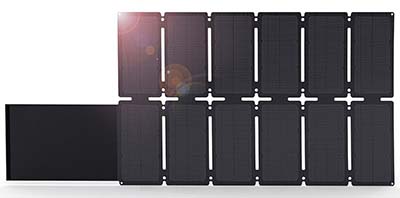
Specs (for 100W charger):
- Panel Type: Monocrystalline
- Weight: 8.8lbs
- Folded Size: 15.16×8.23×3.15″
- Outlets: 2x USB-A (5V, 4.8A total), DC 12-19V, PD Type-C 60W
- Chainable: Yes
- Available At: Amazon
Review:
BigBlue solar chargers come in various sizes. The best ones for camping trips are: 42w, 63w and 100w. When you break down the cost-per-watt, BigBlue actually is one of the cheapest solar chargers available. The 100W charger is an insanely good value and costs almost half the price of the Jackery SolarSaga 100W.
All of the larger wattage BigBlue solar chargers are feature-rich. The tech prevents overheating, supports fast charging, and works even in cloudy weather. They also have multiple out ports (which vary depending on the wattage of the product). Make sure you check the features before you buy!!!
While it isn’t recommended, you can use the larger BigBlue chargers to charge a car battery (according to the company though, it’s better to just use it for jump starting). It is possible to chain multiple BigBlue solar chargers together. You’ll need an MC4 cable which doesn’t come with the kit.
I’d recommend getting the BigBlue 100W as it is the best value and compatible with the most devices. The 28W charger is good if you only want to charge small devices like phones on camping trips.
*I do NOT recommend the 28W BigBlue solar charger. It does not have a blocking diode, which means it will drain batteries instead of charge them in shady conditions. If you need a smaller solar charger, get the Anker 21W instead.
Pros:
- Smart technology
- Easy to use
- Compatible with most devices
Cons:
- Not waterproof
- Confusing options – features aren’t the same across products!
Do You Really Need a Solar Charger when Camping?
Don’t get me wrong: portable solar chargers are awesome and have come a long way. They’ve gotten smaller, more durable, and much more reliable.
But you need to be realistic about what solar chargers can do.
You aren’t going to be able bring a small, cheap solar charger camping and expect it to keep all devices reliably charged. In cloudy or rainy conditions, you might not be able to charge anything with solar.
For this reason, a power bank or power station (which you pre-charge at home) may be a better solution for charging your devices while camping.
What Size Solar Charger Do I Need for Camping?
As a general rule, you’ll need at least a:
- 10W solar panel to charge your smartphone
- 50W to use a laptop a few hours per day
- 100W to run a small camping fridge
- 300-500W to run multiple appliances throughout the day, such as a fridge, lights, game console, and other devices
Note that these are just generalizations. Calculating how much solar power you need for camping is actually pretty complicated. It will vary drastically depending on factors like the efficiency of the solar panels, how much peak light you get, and how your panels are angled.
To calculate camping solar needs:
- List all the devices you want to use
- Calculate how many watts they use per hour
- Multiply the watts by how many hours you will use the device per day
- This gives you your watt hours per day
- Divide the watt hours by how many hours of peak daylight you expect to get per day.
- This is the minimum size in watts your solar panel setup needs to be
- Multiply by 2-5x to account for inefficiency and to have a margin of error
You’ll Need Battery Storage If You Want Reliable Power
If you have high power needs or cannot let your devices die, then you will need battery storage. For small devices, this can be a small backpacking power bank. For larger devices and appliances, you’ll need to invest in a power station like the Goal Zero Yeti.
How to Charge Devices with Solar while Camping
There are two main ways you can use portable solar panels when camping.
Option 1: Directly Charge Devices from the Solar Panel
Almost all portable solar panels have USB outlets. To use them, you simply plug your device into the solar panel, put the solar panel in the sun, and let it charge the device.
Benefits:
The main benefit of directly charging is that it is more efficient. When you use the solar panel to charge a battery and then charge a device, you lose some of the power. It’s lost through the cables, conversion, and through the battery. By directly charging your devices, you will get the most power from the solar panel.
Downsides:
- No way of storing power: If you need to charge your device and it’s a cloudy day, you are out of luck.
- Compatibility: You may not be able to directly charge some devices with certain solar chargers.
- Overheat devices: If you don’t disconnect your device from the solar charger, it might overheat your device and damage it. Good solar chargers have overheat protection but even this won’t completely save your devices from harm.
- Might draw power from your device! If a device is plugged into a solar charger and there isn’t much sunlight, the charger might drain the device battery instead of charge it. Good solar chargers have a blocking diode feature which prevents power from draining out of the device.
Option 2: Solar Panel + Power Bank or Power Station
If you need a more reliable source of power, then you’ll need a battery for your solar panels. This can be a small power bank or a large deep cyclic battery. You connect the solar panel to the battery to let it charge. Then you charge your devices from the battery.
Benefits:
- Can store power for later
- More flexibility: You can choose the size of the battery, type of outlets, and number of outlets to suit your needs.
- Pre-charge battery: Charge the battery at home before your camping trip so you have power when you arrive and just use solar for topping it off.
Downsides:
- More complicated: You may need a more complex solar setup for camping, including a regulator and invertor.
- Less Efficient: Some power is lost when it is stored in the battery and also as it passes through the cables en route to the device.
- Power stations are expensive: If you need to power lots of devices, you’ll need a large power station. These are not cheap.
Solar Charger Terms
Before choosing a portable solar charger for camping, you’ll need to understand the basics of power.
Watts:
Solar panels are rated in watts. It essentially is a measure of how much power the panels are able to produce. Most portable solar panels range from 5 to 100 watts. Anything bigger than 100 watts is probably too large to consider “portable.” Watts are calculated as Volts x Amps.
Volts:
Volts is the energy potential of the solar panel. All USB cables run at 5 volts (thus anything that charges via USB takes 5 volts). Laptop charger cables can be as high as 25 volts.
If you were to try charging your cell phone on a 12 volt solar charger, it wouldn’t be able to handle that much electricity. You’d see sparks and melting plastic! This is why we use invertors with high-power solar panel setups.
Amps:
The amount of electricity that can flow at once is measured in amps. Older cell phones will handle about 1 amp. Newer fast-charge phones will handle upwards of 2 amps. Devices which use more power (such as tablets) usually handle around 2 to 2.5 amps. Laptops might have 5 amps.
Higher amperage means you can charge devices more quickly. For example, it will take longer to charge a laptop at 1amp than at 5 amps.
Confused? A good way to think about watts, volts and amps is using a metaphor of water going through a pipe:
- Watts = total water
- Volts = water pressure
- Amps = size of pipe
If you have high water pressure (volts) and big pipes (amps), then you are going to have a lot of water (watts) going through the pipes.
Watt Hours
Watt hours (Wh) is how much power you need over time. It is measured as Wh = W x time in hours. This is especially important for calculating power needs of devices you will be running frequently, like camping fridges.
Amp Hours
The amount of power a battery can hold is listed as amp hours (Ah). It is calculated as Ah = Wh/voltage. Amp hours is important because it represents the amount of power being used over time.
Choosing a Portable Solar Panel for Camping
Solar Charger vs. Solar Panel
A solar charger is a solar panel which has a USB outlet. It won’t be able to charge anything which uses 12v plugs. By contrast, portable solar panels may only have a DC outlet. Many 100-200W solar panels have both USB and DC.
Monocrystalline vs. Polycrystalline Panels
Mono crystalline are considered the best type of solar panel. By comparison, poly-crystalline panels have boundaries between their crystals; these boundaries reduce efficiency. You’d need a slightly larger poly-crystalline panel to get the same power as a mono one.
Efficiency
Good brands of portable solar chargers will list their efficiency rating. Anything above 22% is a fairly good efficiency. Yes, just 22%. Solar chargers will lose some efficiency over time.
Blocking Diode
A blocking diode only allows power to run in one direction. Without a blocking diode, energy from your device battery might run towards the solar panel, causing it to drain instead of charge. This is very important when charging in cloudy or low-light conditions.
Almost all solar chargers have blocking diodes but some of the smaller or cheaper solar chargers do not.
Price Per Watt
To figure out the value of a solar charger, look at the price per watt instead of the overall price.
Total price divided by watts = price per watt.
Portable solar chargers are getting cheaper all of the time. It used to be that $10 per watt was a good deal. Now you can find quality portable solar chargers that cost less than $3 per watt. As a general rule, larger solar panels are cheaper per watt.
Pay attention to whether the panel is monocrystalline or polycrystalline when comparing prices: poly is cheaper but not as efficient.
Rigid vs. Flexible Solar Chargers
Portable solar chargers are either rigid or flexible. As a general rule, rigid solar chargers are easier to set up but they might crack. Flexible solar panels can withstand some bending but are harder to prop open and blow away easier.
Now that you’ve got power taken care of, what are you going to eat on the trail?
Check out my eBook with over 50 trail recipes and lots of info about meal planning and nutrition for backpacking. Since you made it all the way to the end of this post, I’ll even give you 50% off. 🙂
Get the ebook at 50% off here.
Image credit: Creative Edge Solar- 5 Solar Charger by Mcjones2003, Creative Commons Attribution-Share Alike 4.0 International
Resources for this article:
http://sciencing.com/larger-mah-number-cell-phone-battery-mean-better-battery-15015.html
https://www.researchgate.net/post/Why_must_deep-cycle_batteries_be_used_in_solar_power_systems
https://auto.howstuffworks.com/question219.htm
https://www.centurybatteries.com.au/products/deep-cycle/car-vs-deep-cyclehttp://sciencing.com/larger-mah-number-cell-phone-battery-mean-better-battery-15015.html
https://electronics.stackexchange.com/questions/79279/does-mah-measure-how-long-a-battery-would-last
https://www.tomsguide.com/us/smartphones-best-battery-life,review-2857.html
http://www.newelectric.com/whats-the-difference-between-amps-volts-and-watts/
https://www.ise.fraunhofer.de/content/dam/ise/de/documents/publications/studies/Photovoltaics-Report.pdf
http://energyinformative.org/best-solar-panel-monocrystalline-polycrystalline-thin-film/#thin-film-solar-cells
https://www.voltaicsystems.com/blog/android-smartphone-direct-solar-charging/
https://www.selectsolargadgets.co.uk/cat/170/charing-mobile-phones-with-solar-power
https://www.solarpaneltalk.com/forum/solar/the-pros-and-cons-of-solar-energy/19256-backpacking-need-help


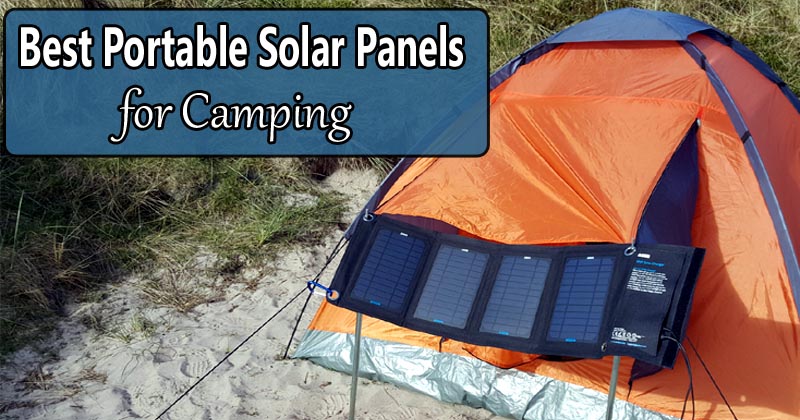
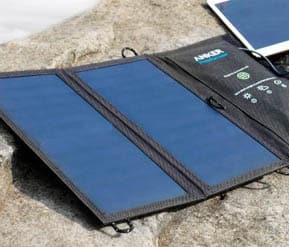
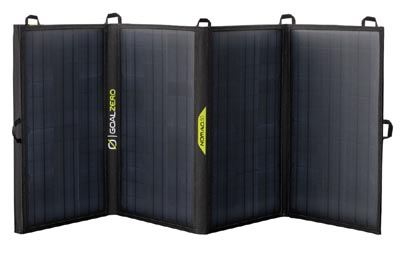
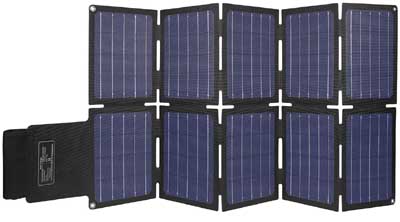


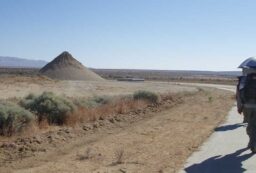








Post your comments